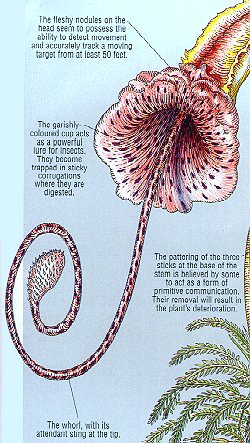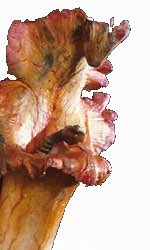Regular readers of my column will already know of the affection I feel for these most maligned of plants. Brought to this isle by the mysterious Umberto Christoforo Palanguez, the Triffid, which is predominately a summer flowerer, was the first of the ‘genetically modified’ plants, appearing long before the tabloid tittle-tattlers got into a stink over the so-called ‘Frankenstein Fancies’.
Palanguez, father of the Triffid
Like most, ‘moving bole’ varieties, the Triffid does grow throughout the winter, (and is therefore vulnerable to hard frost, which makes it quite tetchy) however it is far less agitated, preferring to find a nice dry spot next to the house, the shed, a large garden wall or green house to sit and ‘think’.
New roots appear early spring, and I suggest breaking up the colony (if you are as lucky as I am to have more than one of these delights) once these appear, as Triffids can become quite overwhelming en masse.
Obviously, the enthusiast gardener, like my good self, will be dealing with the ‘docked’ Triffid, the wild Triffid being far more active and aggressive during this time of year, as it hunts for food. A young wild Triffid (measuring up to 1.5 metres) will typically satisfy itself with a diet of flies and other insects which get caught in the cups, with the larger ‘warrior’ Triffid (2-3 metres) thinking nothing of firing its stem at a passing neighbourhood cat or even the neighbour himself.
Moreover, this is what has led the Triffid to be considered a pest, and to my horror, often referred to as a weed. With all proper precautions taken, including ‘docking’, or if an active Triffid, held back from the 7-metres its poisonous stem can reach, the Triffid is the most beautiful and rewarding garden plant there is.
Most domestic Triffids are 'docked' at the nursery
As for the colour, the rich green ‘feet’ can seem almost black in most lights with the puce leaf being simply breath taking. As spring turns to summer and the long dusty evenings fuse with this adoring plant, the puce darkens to an invigorating blood red, as if the Triffid has gorged itself on a Titchmarsh or a couple of Monty Dons. However, the leaves are subject to fungal disease, so it is recommended that you ask your supplier to provide a systemic fungicide that will offer year round protection.
If you have not already taken the plunge and made the investment in a Triffid, do remember that although they are an extremely hardy plant, requiring minimal practical gardening care, they do like plenty of 'physical' attention and ‘roaming’ space. Once docked, they are perfectly safe around the family pet, but can give ‘loose’ babies a rather nasty suck.
"Love me, hug me, feed me the cat"
Any questions on how to successfully grow and care for a Triffid, please post below.





18 comments:
Blighty doesn't have much of a garden so we wonder if it would be possible to plant a triffid in the top of our wall or in a pot.
Yes, it is possible to plant in the top of a wall or pot, however you must remember that the Triffid is a wanderer, and typically will start to get 'out and about' after about six months.
If you do have room in the house to let it 'lollop about' this should also work okay.
Nice of you to drop by Blighty.
Triffid leaf-wilt is often a symptom of a dying plant. Sorry to be the bearer of bad news.
Herge, you fucking whore! Who are all these people who are suddenly leaving comments on your blog? Bitch!
Firstly, you have to be careful how much Titchmarsh you feed your Triffid. A Titchmarsh can be a bit sugery for the Triffid in spring.
If it's a docked Triffid it may be in need of a cosy cuddle, or if an active Triffid, maybe chuck it a small dog, I suggest a Jack Russell or a couple of Daschunds (miniture).
Hope this helps.
I'd love to put one on my neighbor's (a.k.a. Slag Man) balcony - I don't know that Los Angeles weather would welcome one however. I saw absolutely breathtaking footage of this plant in action in a botany lecture. Amazing.
Millicent-
I believe that they positively thrive in the California sun, although I understand no one walks in L.A. which might bugger the Triffid.
You are right though, magnificent in action. The government here has just banned using them to hunt foxes. Whatever floats ya boat right.
Tina -
You are still my FAV N0.1 BLOGGER. And no mistake.
I think it's the Triffids, people just love them - you're wrong about the wilting leaves though, they just need fresher meat.
Do triffids respond well to breast milk?
Over to you, Herge.
If you have breast milk, and you fancy feeding it to your triffid I say go for it.
Just don't feed it from the tap, so to speak, can get quite messy.
I should do a follow up on the Triffid questions...
or maybe not.
Come on Tina, POST POST!!
...I love that old movie, The Day of the Triffids...
CLASSIC!
I suppose I'd better get creative and do something cakesniffy then. I can feel one of my heads coming on.
Over to Cakesniffers. (Give me half an hour and I'll think of something).
I was thinking of crossing my triffid with a Piranha Plant do you have any tips?
In your experience, are the results kid-friendly?
One of my triffids is suffering from Apple Scab. I've heard that frequently if a disease is obvious it's too late to treat, so I'm not hopeful, but is there anything you can suggest?
How effective have you found mulching?
We've tried eggshells, but unfortunately dogs and other creatures tend to eat them. But we've had other successes. One is pumice, which is now coming on the market, it's a lava-type rock used as a mulch. The best thing though, we've found - and I really do rate it as a really good slug control - is pine needles.
Triffid husbandry is the thing I love to do best. You're in touch with the environment, the seasons, the whole cycle of life.
Dunno how I came across your blog but I'll be returning...first time I've laughed out loud this evening! Nice one!
Edwaado, if I may I shall run a complete answer and question session at a later date. The Flatland Gardener will answer though, have no doubt.
Weenie, nice of you to drop by, glad you enjoyed the visit. Always good to hear people laugh at my jottings.
WoW! What a response! Do you think I could have some of your traffic, or are they all running over Cakesniffer Tina's friends disguised as Tony Blair?
Yes, I'm back. Didn't mean to torment your already tortured soul. Won't leave for so long again, I promise!
I've missed you guys!
Sam
I just swallowed a Trifid seed by accident and my brother told me a Trifid will grow out of my stomach now and eat me alive.
Is he for real?
Post a Comment